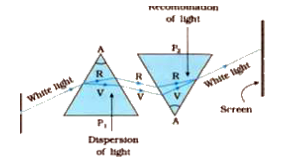Text Solution
Verified by Experts
|
Topper's Solved these Questions
THE HUMAN EYE AND THE COLOURFUL WORLD
KUMAR PRAKASHAN|Exercise TEXTUAL EXERCISE|13 VideosView PlaylistTHE HUMAN EYE AND THE COLOURFUL WORLD
KUMAR PRAKASHAN|Exercise ADDITIONAL QUESTIONS AND ANSWERS|9 VideosView PlaylistQUESTION PAPER-2 (MARCH,2020 - BOARD'S QUESTIONS PAPER)
KUMAR PRAKASHAN|Exercise Section - D (Answer the following questions)|3 VideosView Playlist
Similar Questions
Explore conceptually related problems
Knowledge Check
A
B
C
D
Submit
Similar Questions
Explore conceptually related problems
KUMAR PRAKASHAN-THE HUMAN EYE AND THE COLOURFUL WORLD-Practical Skill Based Questions with Answers
- How did Newton show that white light of the Sun (sunlight) contains se...
05:02
|
Playing Now - Dispersion is caused by refraction and not by reflection. Why?
01:23
|
Play - A beam of white light falling on a glass prism gets split up into seve...
03:37
|
Play - When a beam of white light is passed through a triangular glass prism,...
01:37
|
Play - A narrow beam PQ of white light passes through a glass prism ABC as sh...
02:58
|
Play - (a) A narrow beam of white light is incident on three glass objects as...
03:30
|
Play
